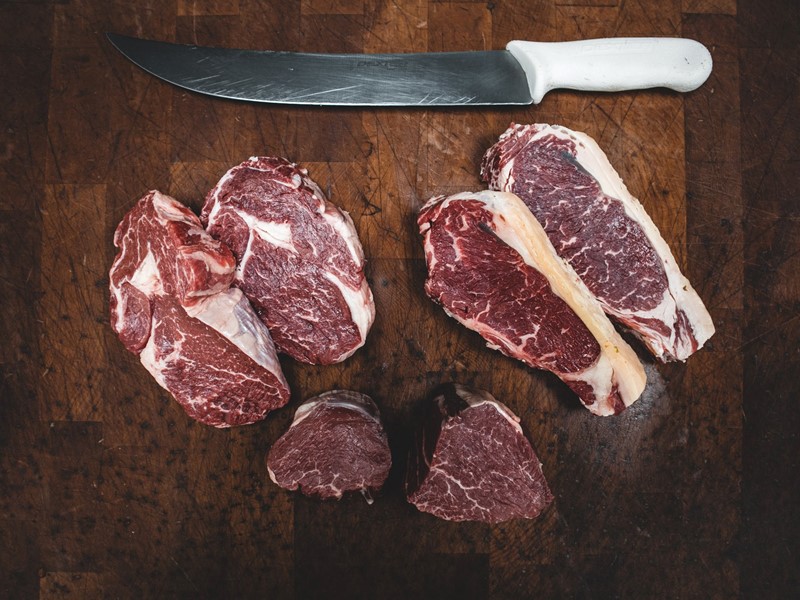The 4 Factors For the Perfect Meat Cutlery

The right tool for the right job is as meaningful a saying in the world of meat cutlery as anywhere else. A flimsy knife through a beef shank can ruin the cut or even further dull your blade. You wouldn’t use a butter knife to hack through a jungle, so make life—and cutting meat—easier with these four-factors for the perfect meat cutlery.
Factor 1: The Blade
It should go without saying, but a sharper knife is a more efficient knife. Eliminating the possibility of frayed cuts and jagged slices can ensure an evenly seared steak. As a common reference for sharpness, slicing through a magazine or newspaper should be easy and effortless as you cut vertically down its fullest thickness. For experienced chefs and knife connoisseurs ONLY, cutting the longest part of your fingernail can also determine the efficacy of the blade.
For larger cuts of meat, a blade between 8-10 inches long can generally add more surface area to slice through the entire cut without the unevenness of adjusting your knife. In addition to sharpness, beginning the cut with the heel of your knife, or the point closest to your handle, adds the most weight and closest control to begin slicing down and outward from your body.
Blade Sharpening
If you notice a dull blade, using diamond-edged or ceramic stones are some of the most cost effective and common tools in an everyday kitchen. For the more sophisticated and modern sharpening methods, electric sharpeners can simultaneously sharpen both edges without the repetition of stone-sharpened approaches.
If you decide to use a stone-sharpened approach, apply water or oil (only one or the other throughout the lifetime of a knife) to the stone for added lubrication and heat reduction. Beginning with the heel of your knife at a 20-30 degree angle, apply pressure from one end all the way to the tip, sliding toward yourself approximately seven to eight times depending on the dullness of your blade. Repeat this step on the opposite side of your blade, then repeat the sharpness test to verify the integrity of your cut.
Factor 2: The Handle
As one of the most recommended and important handle/blade designs, procuring cutlery with a blade fully embedded down the entire length of the handle ensures maximum support and strength for cuts of any kind. You may have heard horror stories of blades breaking at the bolster (tip of the handle before the knife begins) and slamming into unprotected hands. This is likely due to an insecure connection between the blade and handle, which is easily preventable with properly designed cutlery.
Various handles are made throughout the cutlery arsenal, and consist of the following options:
- Plastic: Widely considered the most purchased and available, plastic handles are easy to wash and easy to find. However, plastic is susceptible to UV damage and breakage over time. Without added rubber grip support, handling plastic on heavy-duty cuts could prove slippery and inconvenient.
- Wood: Aesthetically pleasing and more durable than plastic, wooden handles require constant care after use. As with most wooden components, water can absorb into the grains causing rot and deterioration. Regular use of mineral oils can help prevent added wear over time.
- Stainless Steel: Used in professional kitchens across the globe, stainless steel surfaces prevent bacteria like no other, making cleaning and sanitization the easiest of the three. Some stainless steel knives are built in one solid piece connecting the blade and handle all-in-one, making a heavy and sturdy knife built to last.
Factor 3: The Weight
Generally considered a personal preference, the weight of your cutlery depends on you. For some, a lighter knife can be easier to maneuver. For others, heavier knives allow gravity to help slice through thicker cuts of meat. Whatever your preference, use what’s most comfortable to you to determine the weight of your cutlery.
Factor 4: The Type
Cutlery of various shapes and blade sizes are available for specialized purposes. In fact, dozens of knives are available to help in cutting meat, produce, garnishes or more for the most precise cuts. Below are some of the most common meat cutleries used in kitchens throughout the world.
- Chef Knife: One of the most versatile knives in practically any kitchen, chef knives provide a means to almost any cutting end. Designed as an all-in-one tool, you can mince, slice and dice to your heart's content.
- Butcher Knife: A knife in the quiver of any true meat cutter, butcher knives trim fat and slice through the hardest cuts of meat. The added curve on most butcher knives helps smoothly slice without added fraying on meat.
- Slicing Knife: A thanksgiving staple, the slicing knife comes long and sharp to precisely portion turkey, ham or sirloin steaks.
- Carving Knife: Similar to the slicing knife, carving knives come with a slight curve and a thin blade to accurately slice portions of your choosing.
- Cleavers: Recognizable in cartoons and horror movies everywhere, cleavers are lightweight, wide and some of the largest you’ll find. Excellent for meat or produce, their wide design can universally crush or chop most foods in the kitchen.
- Boning Knife: Depending on the meat, boning knives provide thin and, sometimes flexible, means of removing meat from the bone. The varying shapes, sizes and flexibilities of these knives allows users to separate meat from practically anywhere on the bone.
You can’t unscrew a flathead screw with a Phillips screwdriver, an analogy fitting for meat cutlery in turn. So before procuring your meat cutlery, consider its purpose and the meat you’ll be using most. These details can save time, money and meat depending on its use, so think wisely as you broaden the tools in your meat cutlery arsenal.